This delicious chocolate shortbreads recipe delivers everything you love about traditional shortbread – a rich, buttery flavour and a delicate, crumbly texture.
Each bite melts in your mouth with a lovely snap from the shortbread. The addition of cocoa makes these cookies extra special. Be warned, the cookie dough is incredibly addictive so it's hard to resist sneaking spoonfuls before baking!
Cut into fun shapes with cookie cutters or leave plain – either way, this recipe yields irresistible chocolate shortbreads. Drizzle with chocolate, dip in chocolate or add a sweet sugar coating for extra crunch.
To help you make these cookies successfully, please read our Top Tips section further below before you start.
If you'd like another easy-to-make cookie recipe like these chocolate shortbreads, try these peanut butter chocolate chip cookies or these award-winning condensed milk cookies.
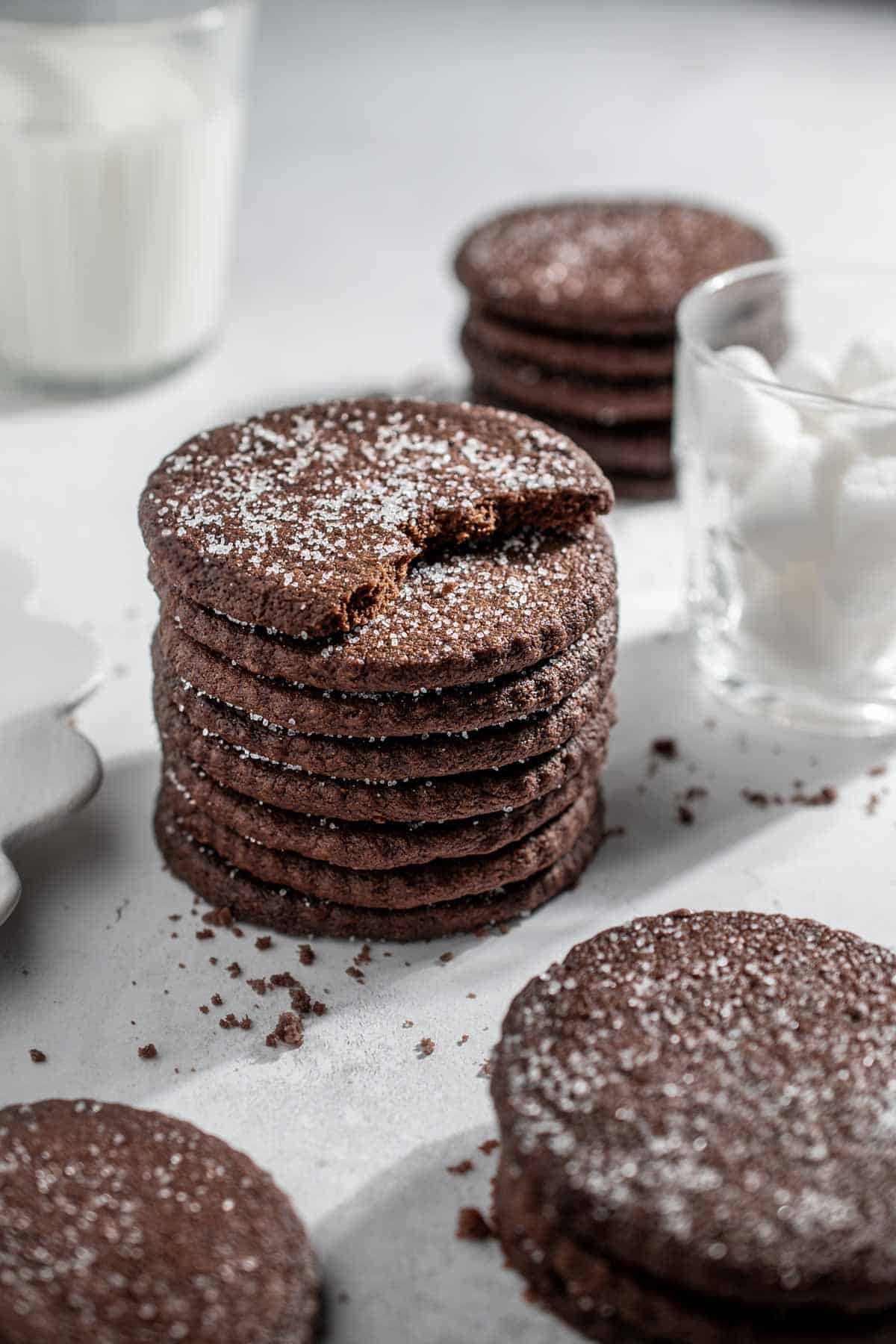
Jump to:
What's to love about this recipe
- Provides a crumbly, rich and buttery flavour.
- Eggless.
- Cut into fun shapes using cookie cutters.
- Yields cookies with a lovely snap when you bite into them.
- Uses simple ingredients you probably already have in your pantry.
- Perfect for gifting.
- This chocolate shortbread recipe is easily customised with add-ins like nuts or chocolate chips.
- Zhoosh them up by dipping them in chocolate, adding a chocolate drizzle or sprinkling with sugar.
Key ingredient notes and substitutions
**Please see the recipe card at the bottom of this post for the full list of ingredients.
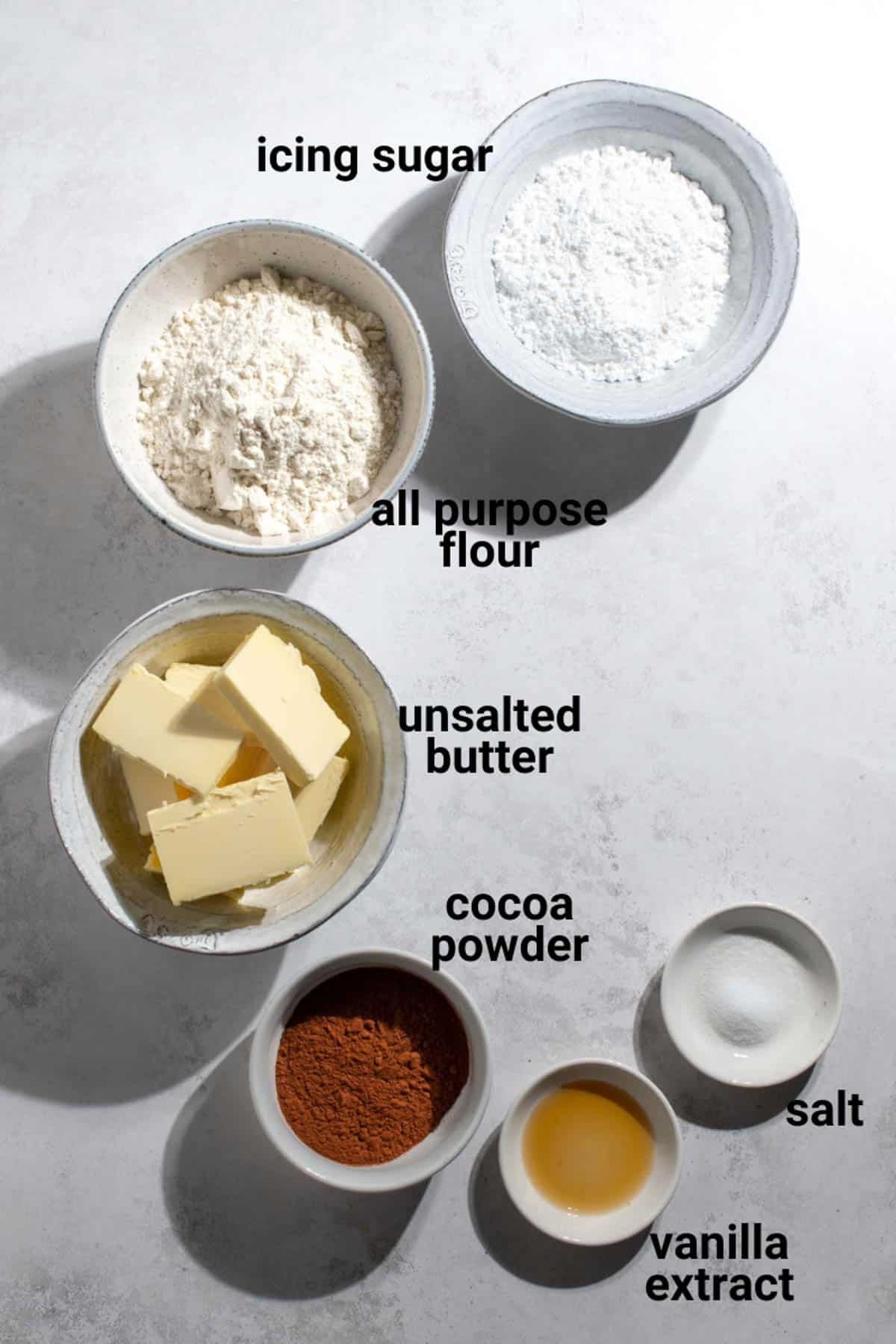
Unsalted butter
Use good quality, room-temperature butter for the best flavour. Unsalted butter is ideal so you can control the saltiness. You can use salted butter as well, just omit the salt the recipe calls for.
Quality butter is essential for giving shortbread its famously rich, creamy taste. Unfortunately, the unique properties of butter cannot be replaced with substitutes like shortening or margarine.
Make sure your butter has softened to room temperature before mixing. This will incorporate air for the perfect tender yet crisp texture.
To speed up the process of softening butter, you can use a microwave-safe glass bowl. Fill it with about an inch of water and heat it in the microwave until the water boils.
Remove the bowl from the microwave, discard the water, and quickly turn the bowl upside down over the butter. The residual heat from the bowl will soften the butter, making it easier to work with.
Icing sugar
Icing sugar, also known as powdered sugar or confectioners' sugar, is used in this recipe instead of granulated sugar for a few important reasons.
- Icing sugar dissolves more easily without the grittiness of granulated sugar. This helps create shortbread with an ultra-smooth texture.
- Icing sugar also contains corn starch which absorbs moisture, resulting in shortbread that is tender on the inside yet still crisp on the outside.
- The fine texture of the icing sugar incorporates seamlessly into the butter and other ingredients.
Cocoa powder
We highly recommend using a good quality Dutch-processed, 100% unsweetened cocoa powder like Valrhona, Callebaut or Ghirardelli.
Otherwise, use the cocoa powder available to you.
How to make this recipe - Step-by-step
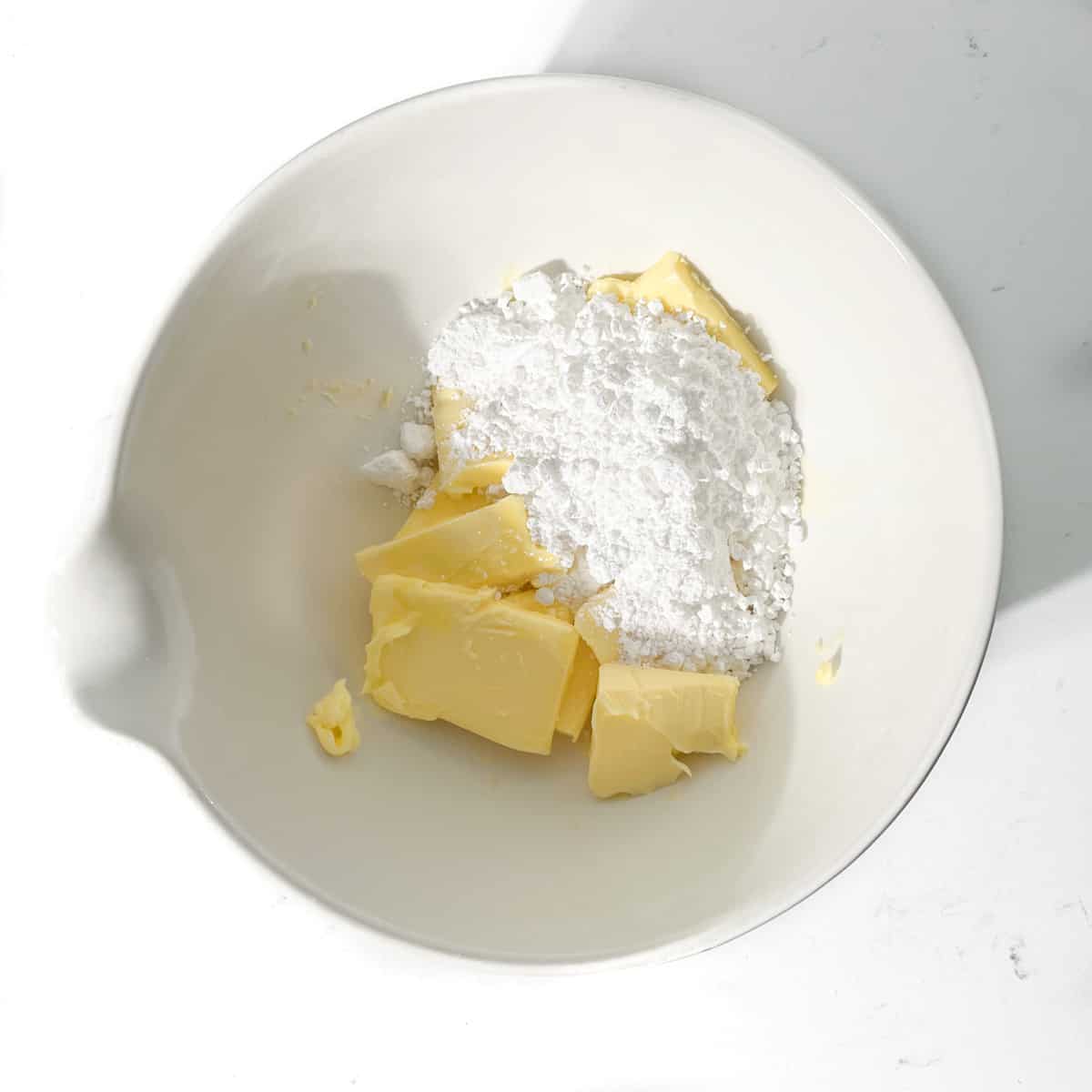
- First, add the softened butter and icing sugar to a large bowl.
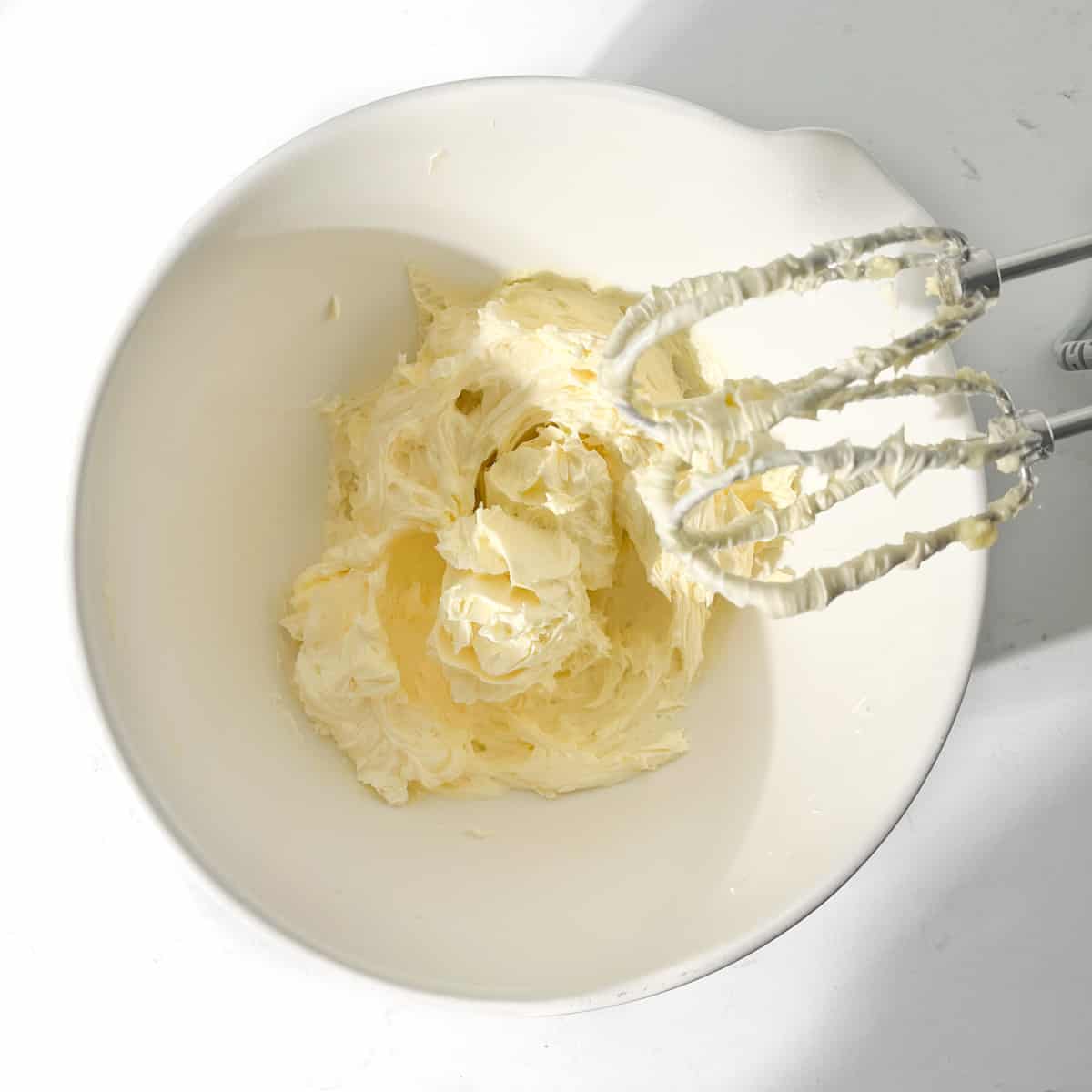
- Using an electric handheld mixer or stand mixer (with paddle attachment), beat the butter and icing sugar together until light and fluffy, about 2-3 minutes.

- Next, add in the cocoa powder, salt and vanilla extract to the butter and sugar mixture.
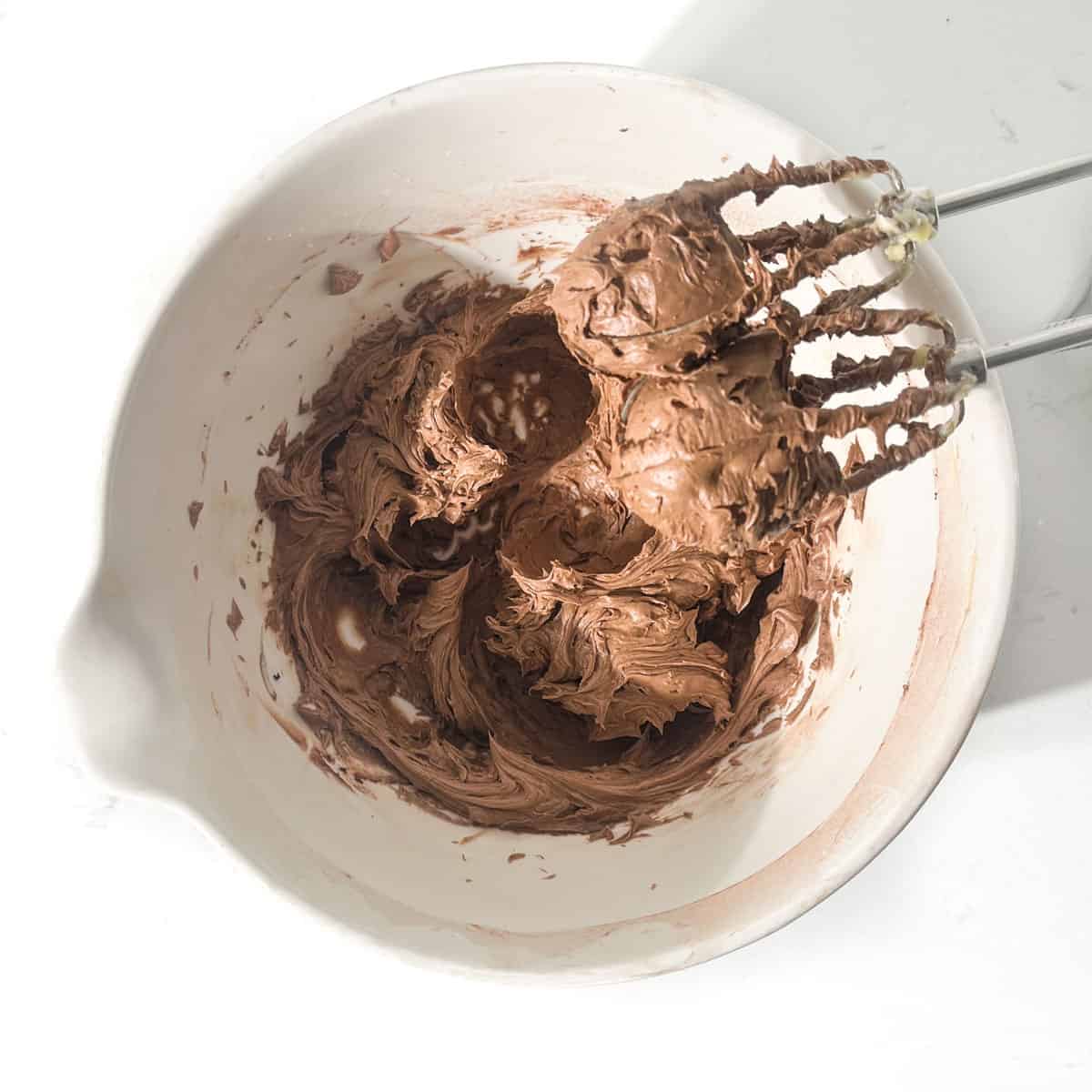
- Beat until everything is thoroughly combined and you have a smooth, creamy mixture.
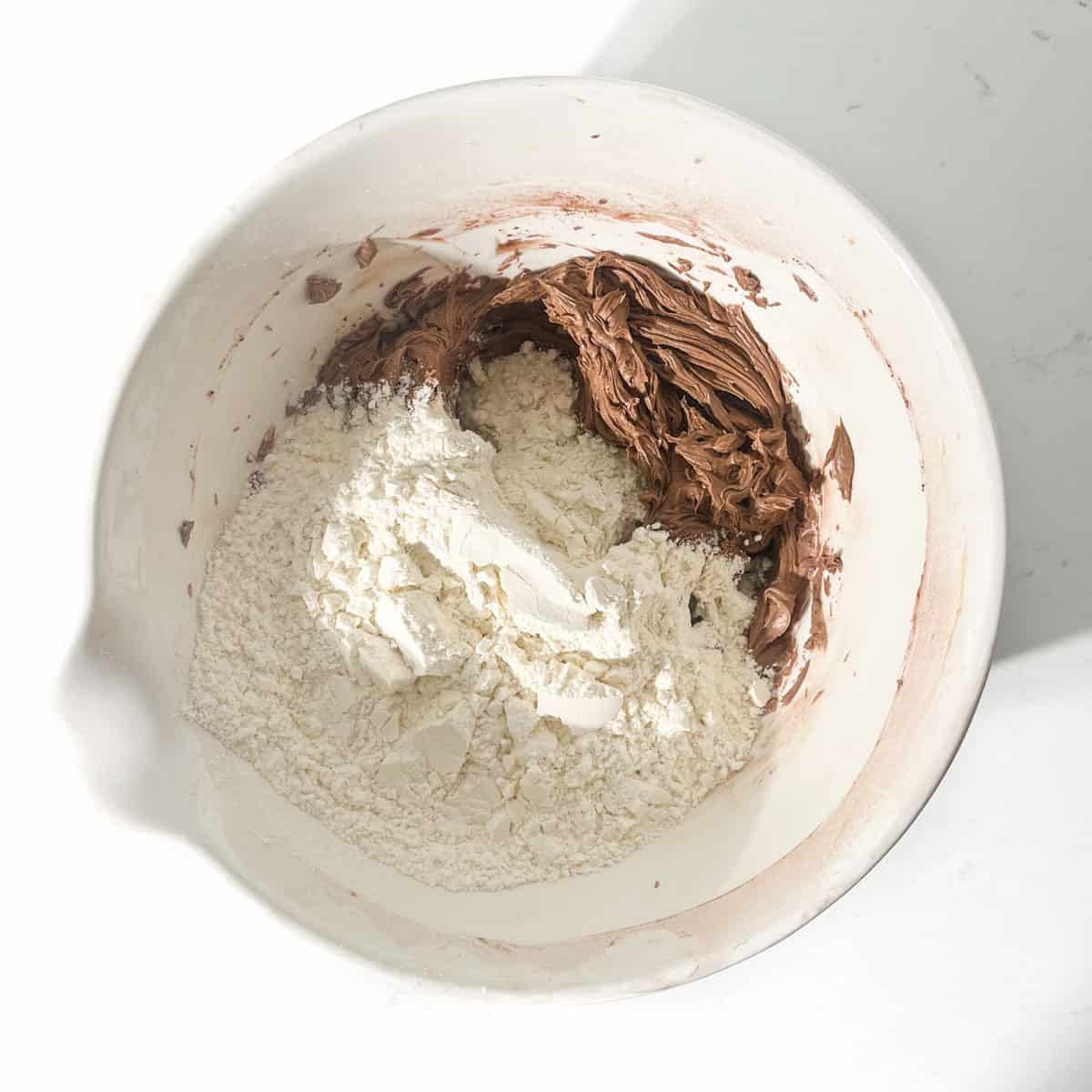
- Add all of the all-purpose flour to the bowl.
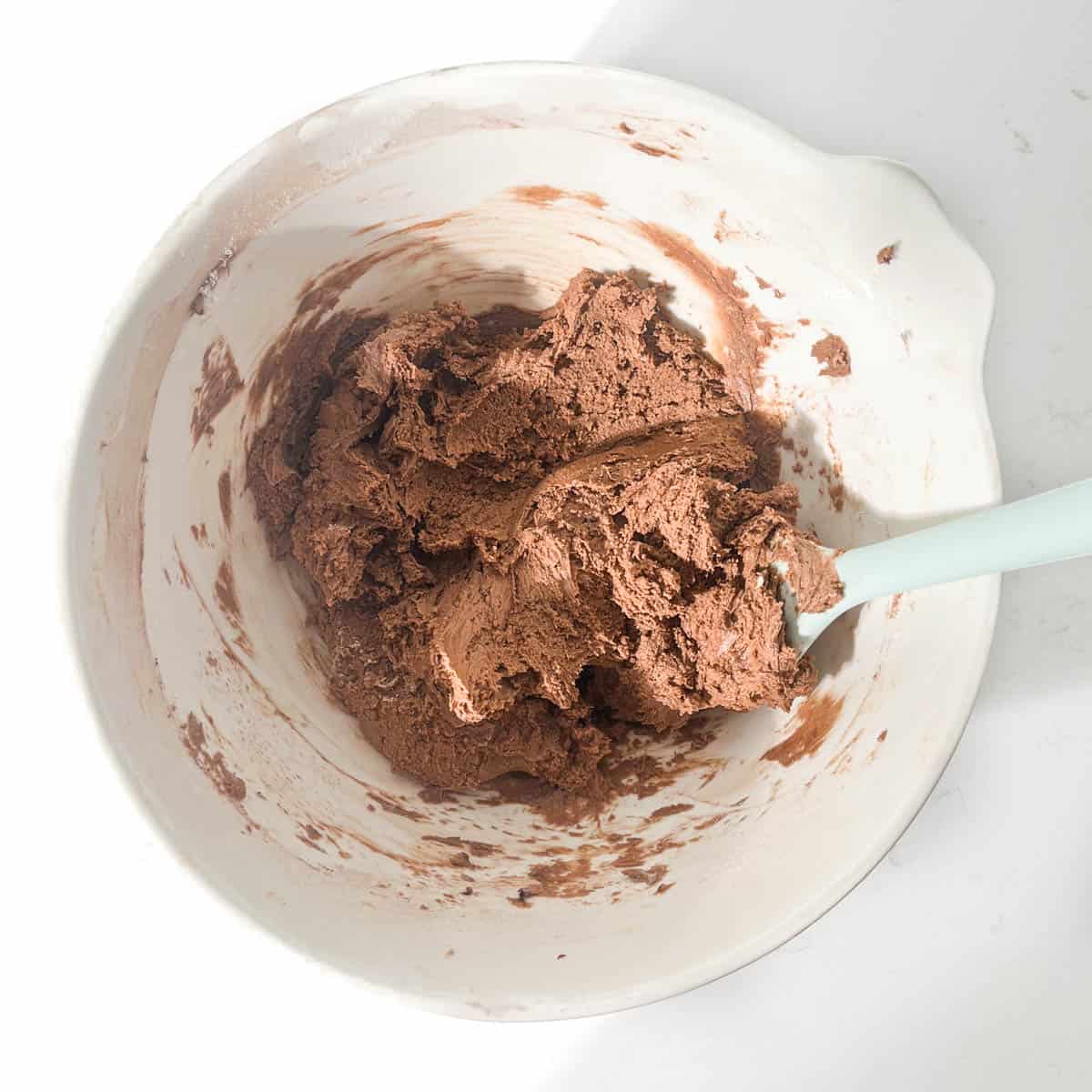
- Slowly beat just until you cannot see any more specks of flour. We recommend starting with the electric mixer and finishing by hand (with a wooden spoon or rubber spatula), scraping down the sides and bottom of the bowl.

- Tip the chocolate shortbread dough out onto a piece of plastic wrap on the work surface. The dough will be quite soft but we are going to firm it up in the fridge.
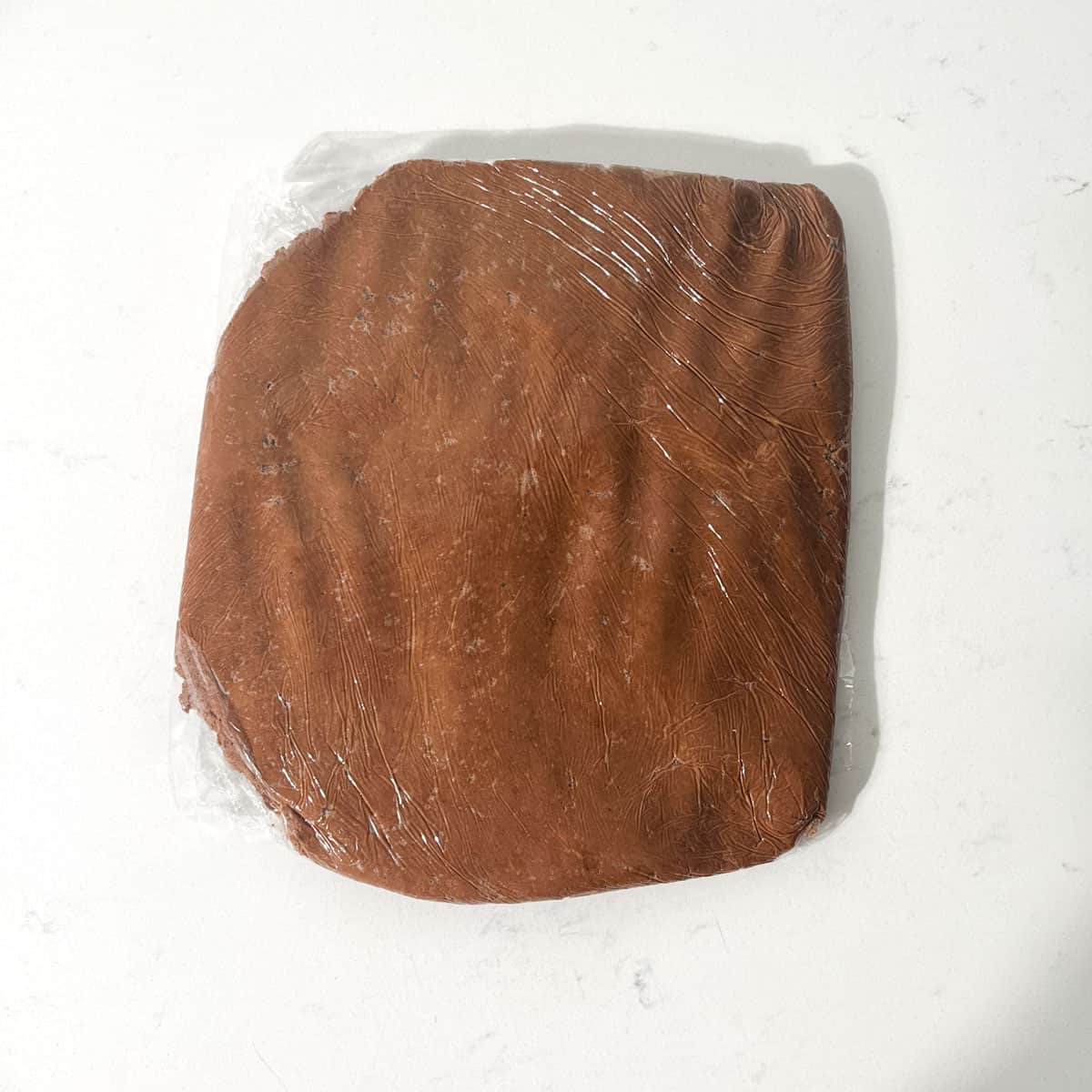
- Shape it into a flat disk and wrap it in the plastic wrap. Place in the fridge for a minimum of 1 hour, or in the freezer for 30 minutes.
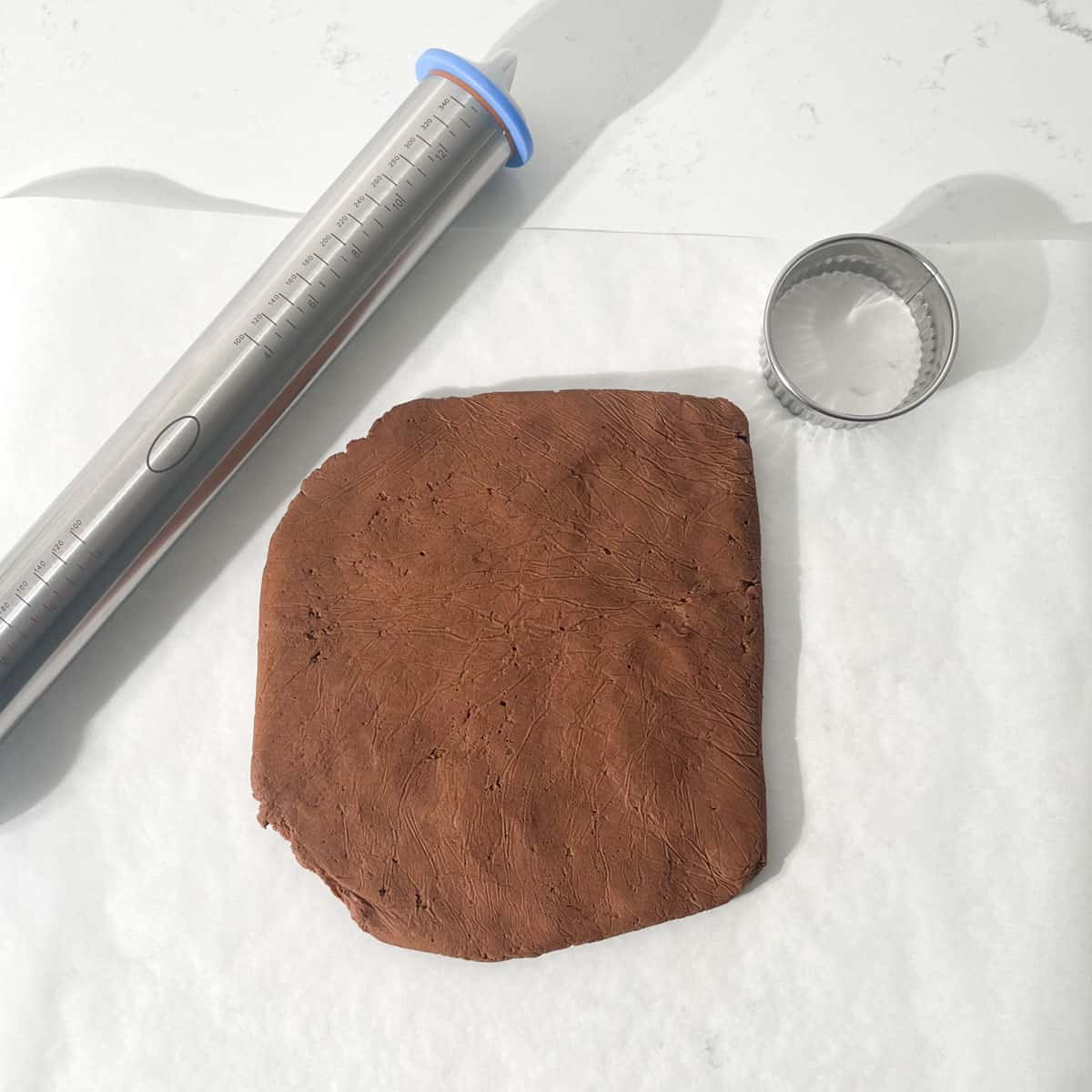
- Once the dough is cold and firmed up, unwrap it and place it on a large piece of parchment paper.
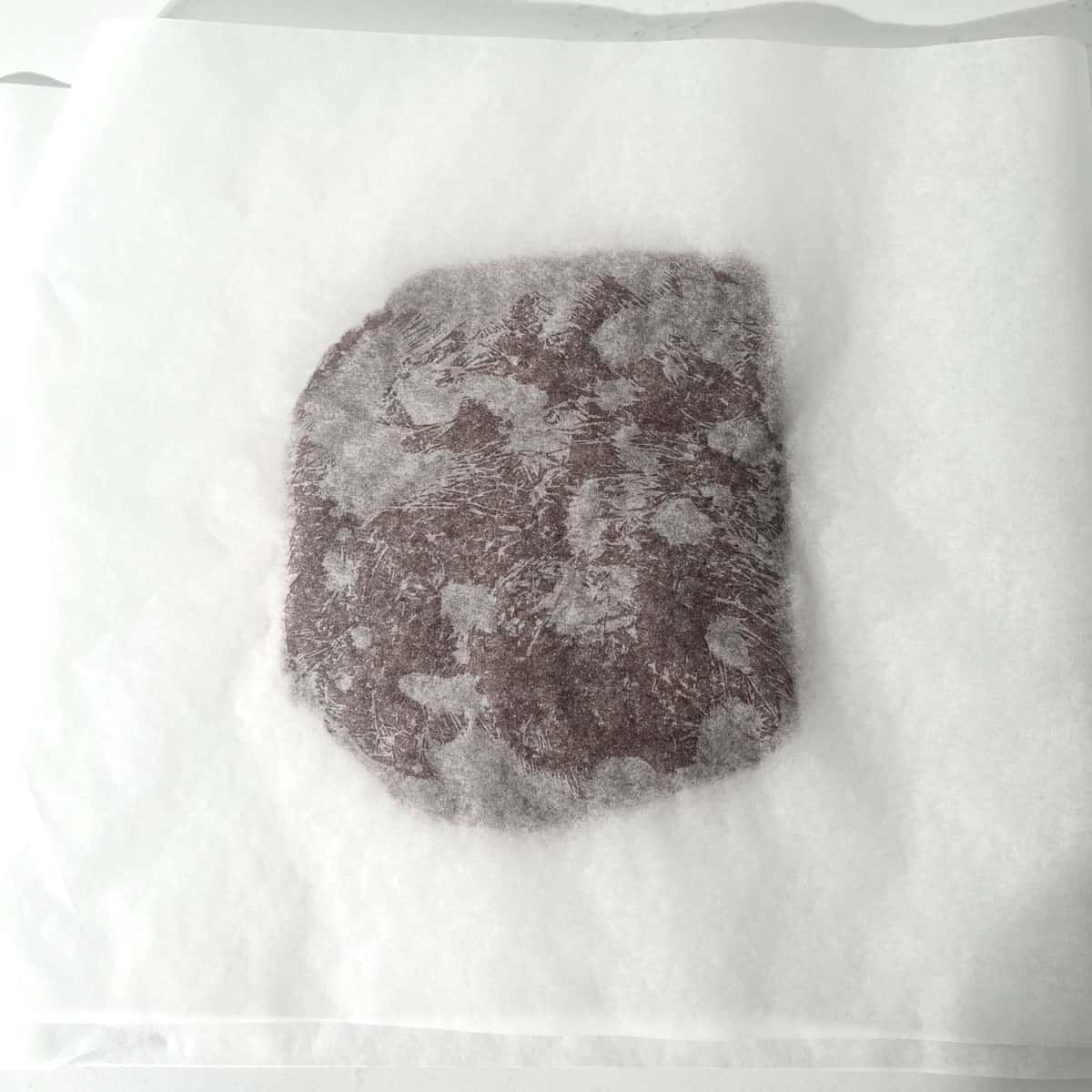
- Cover it with another piece of parchment paper.
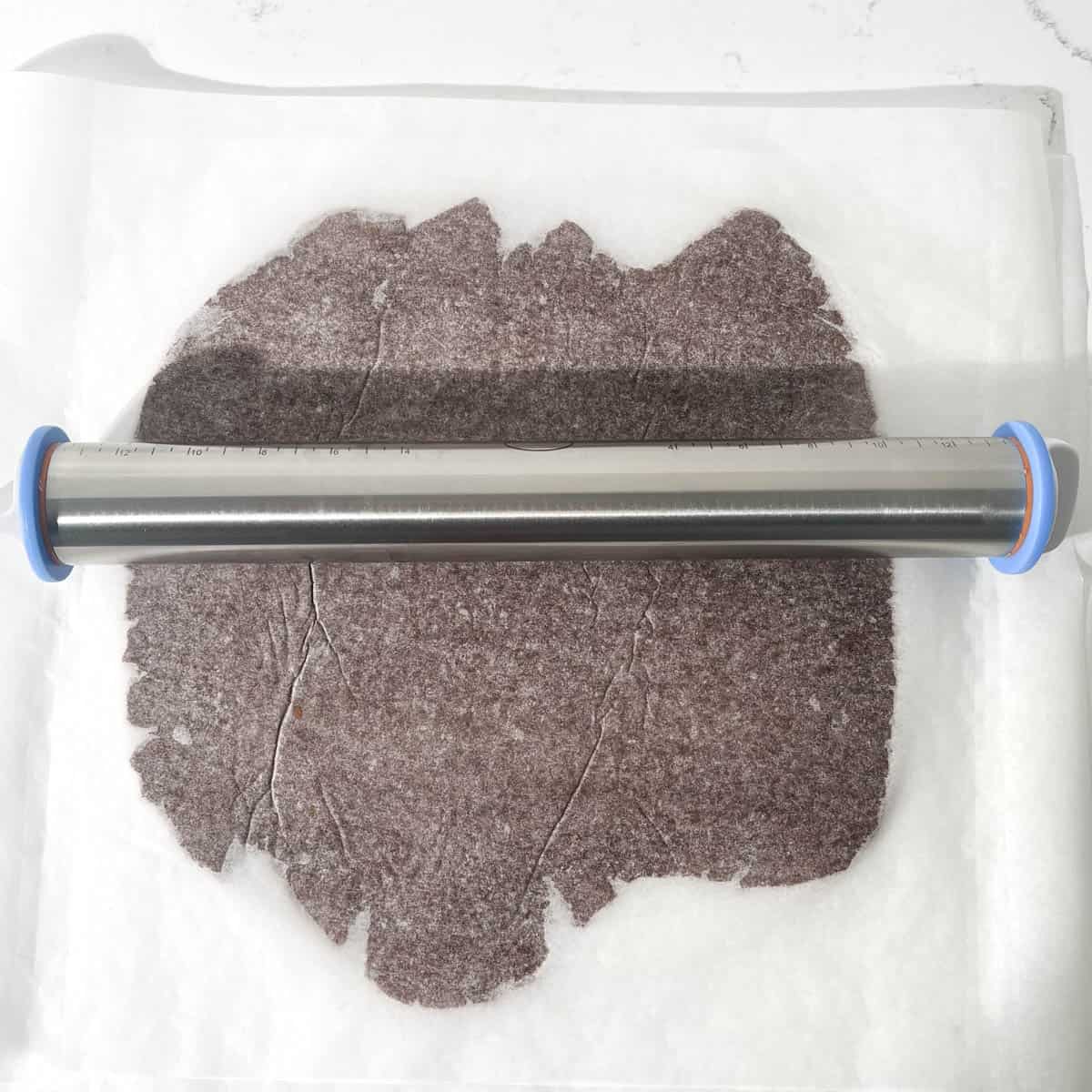
- Using a rolling pin, roll the dough out to a thickness of 6mm/1/4".
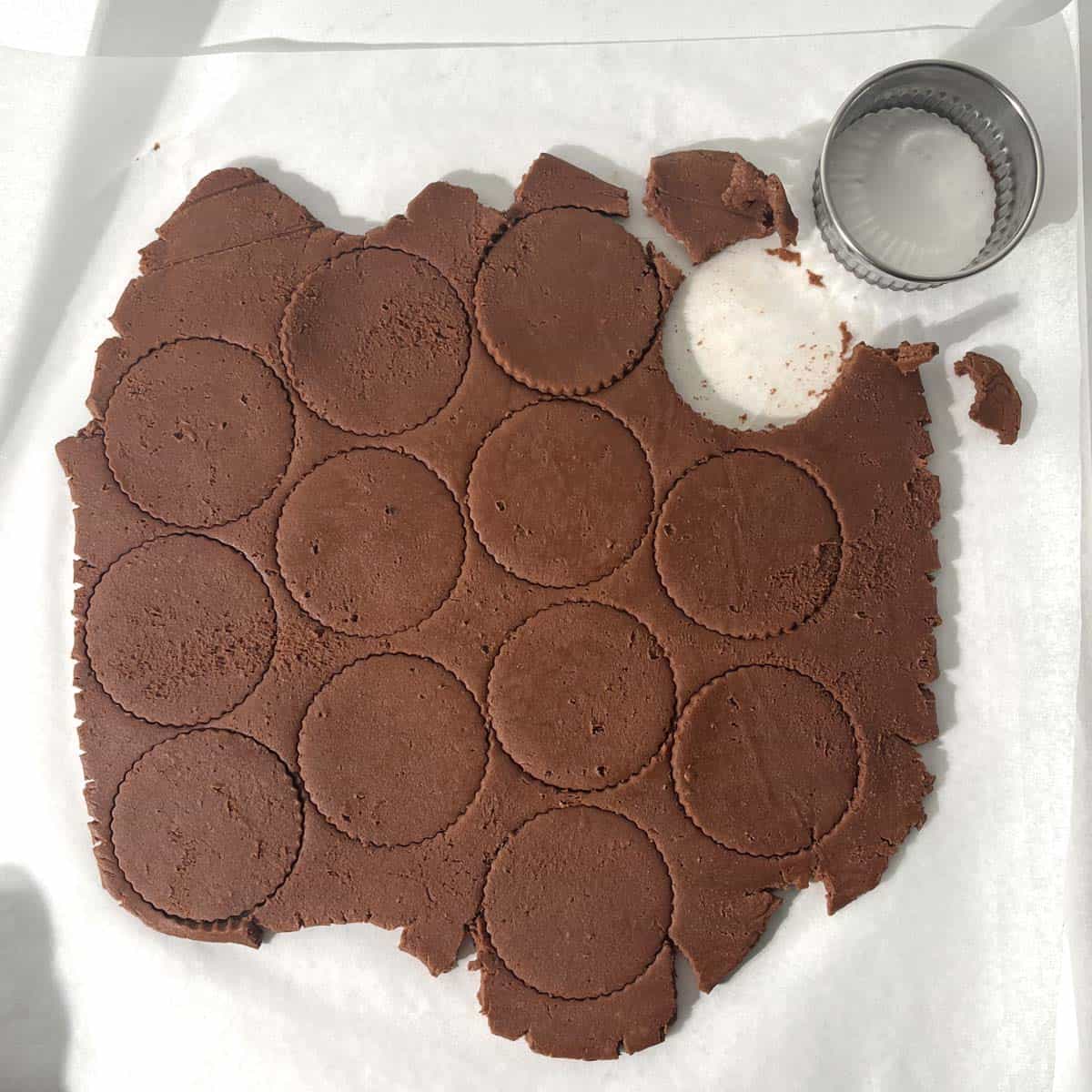
- Cut out your desired shapes from the dough using a cookie cutter. Re-roll any leftover pieces of dough. If the dough has gone soft, return it to the fridge for 10 minutes.
- Line two baking sheets with parchment paper and transfer the cut out cookies onto the sheets, leaving enough space between them for expansion.
- Place the baking sheets in the fridge to firm up the cookies.
- Preheat the oven to 170C/338F/gas mark 3.
- Once preheated, bake the cookies on the middle shelf of the oven for 15-17 minutes. Since the cookies are dark, you won't have visual cues like with light cookies. Look for a dull surface and dry edges to know they are done.
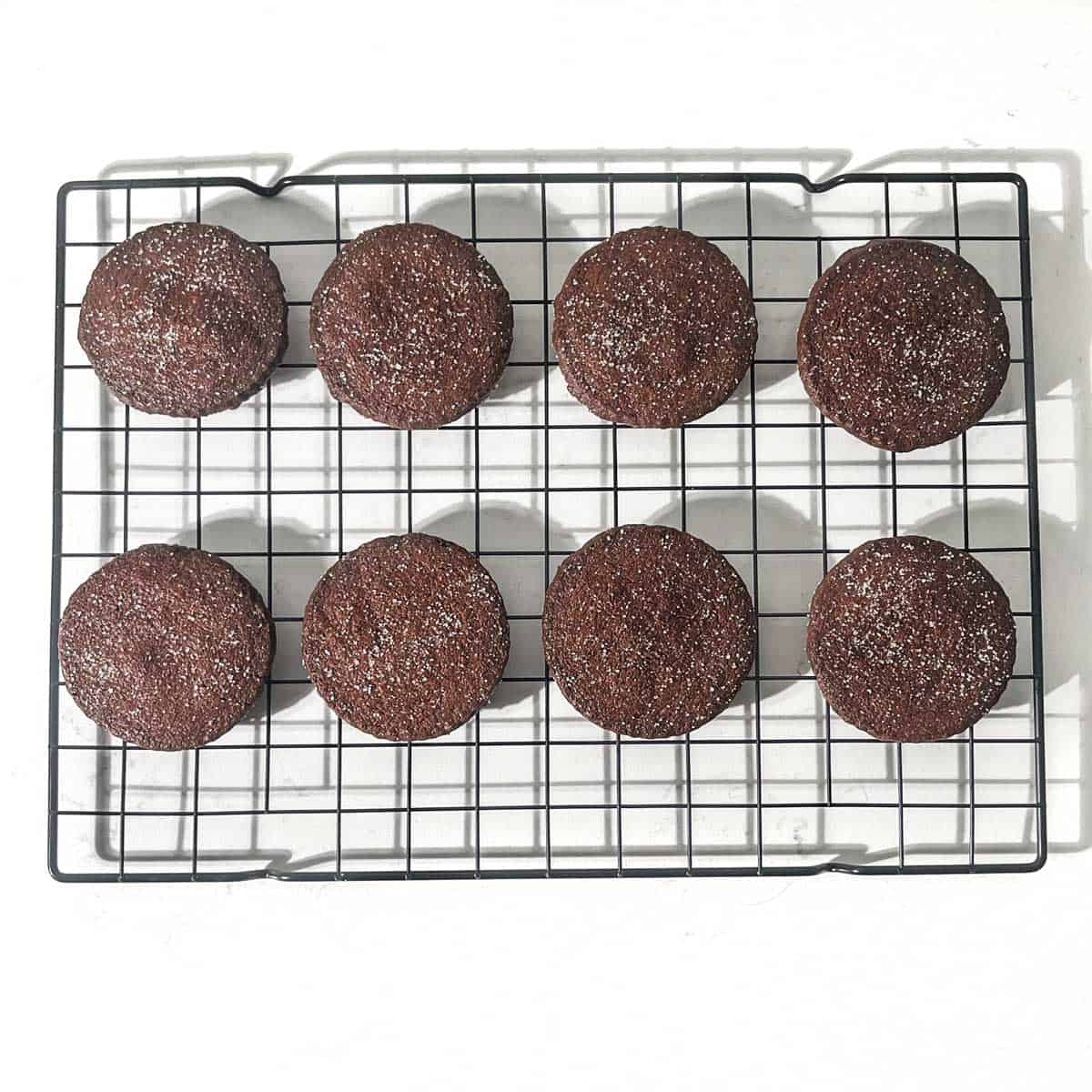
- Leave the cookies on the trays for 10 minutes before moving them to a wire rack to cool completely.
- If you wish, sprinkle them with granulated or caster sugar as soon as they come out of the oven. Gently press down to make the sugar stick.
Top tips
Weigh your ingredients accurately
Using a digital scale to weigh out your ingredients will always give you more accurate results. If you haven't got a set of digital kitchen scales, consider adding it to your Christmas list.
Don't overmix the dough
For best results, don't overmix the cookie mixture. Overmixing might lead to tougher cookies. Gently fold the ingredients together and stop as soon as everything has been incorporated.
Chilling the dough is a *must*
The dough is fairly soft, so chilling it in the fridge before rolling and cutting is essential.
After mixing, shape the dough into a flat disk, wrap it in cling film and chill it in the fridge for at least 1 hour or in the freezer for 30 minutes. This firms up the dough and makes it much easier to work with.
If any leftover dough scraps soften up while cutting shapes, simply return them to the fridge for 10 minutes to firm up again.
Another great technique is to roll out the dough on parchment paper to the desired thickness right away, transfer it to a baking sheet and place the sheet in the fridge until firm before cutting shapes.
Chilling helps retain the dough's shape for cutting neat cookies. So, take advantage of your fridge or freezer to ensure these cookies turn out just the way they should.
Re-chill the cut out cookies before baking
Re-chilling the cut out cookies before baking is an important extra step. While rolling and handling the dough, it can start to warm up and soften, especially if your kitchen is hot, you're under bright lights or your hands run warm.
Wait to preheat the oven until after you have transferred all the cut out cookies to a cookie sheet and returned them to the fridge to firm up one last time.
This second chill hardens the dough again and helps the shapes retain their form when hit with the heat of the oven. So really, really resist the urge to bake them immediately! Allowing the cut cookies to re-chill will ensure you end up with beautifully defined edges and details.
How to tell if your cookies are done
With chocolate cookies, it can be tricky to gauge doneness since you don't have the same visual cues as lighter-coloured baked goods.
- First, trust your nose - when they're done baking, you'll smell that irresistible chocolate aroma.
- Check the surface of the cookies too. When done, they will have a dull, matte look rather than a glossy wet appearance.
- Press gently on the edges of the cookies. If they feel quite firm and almost dry, they are likely fully baked.
- Keep in mind that cookies continue cooking even once removed from the oven. To avoid overbaking, be cautious and pull them when you think they seem just shy of done. It's better to have cookies that are slightly underbaked rather than dried out.
Let your senses guide you and you will master perfectly baked chocolate shortbread.
A bonus 'nice-to-have'
Invest in a rolling pin with built-in guides or adjustable add-on guides for easy, tidy rolling. The guides act as a frame of reference so you can roll the dough precisely to the desired thickness all over.
Perhaps something else to add to your Christmas list!
Decoration ideas for chocolate shortbreads
- Drizzle with melted chocolate. A white chocolate drizzle gives a nice contrast.
- Dip halfway into melted chocolate.
- Roll the edges in chocolate sprinkles.
- Sprinkle with granulated sugar or cinnamon sugar.
- Sprinkle with crushed nuts like pecans or walnuts.
- Press mini chocolate chips into the tops.
- Add some colour by pressing Smarties into the top of the unbaked biscuits, as we did here with these Smartie cookies.
- Decorate with royal icing and sprinkles.
- Add mini chocolate chips to the dough before baking.
- Sandwich two together with buttercream frosting.
- Spread jam, Nutella or marshmallow fluff in the centre.
- These delicious cookies go great with peppermint extract added to the mixture.
- Coat in melted dark chocolate and sea salt.
Why it's better to roll on parchment paper
- The parchment paper prevents sticking without adding extra flour that can dry out the dough.
- It keeps the work surface and rolling pin clean for easier clean-up.
- Flour can work into the dough, creating a chalky texture in the baked cookies.
- The parchment paper contains the dough neatly and makes it easy to flip over and reroll scraps.
- You really don't want white flour sticking to chocolate cookies.
- A floured surface can lead to uneven dough thickness and tearing.
- Excess flour can burn on the bottom of the cookies while baking.
Storage suggestions
Store the baked cookies in an airtight container at room temperature for up to 1 week. Plastic, glass or metal containers all work well.
For longer storage, freeze the baked cookies for up to 3 months. Let them thaw at room temperature before serving.
Place strips of parchment paper between the layers of cookies to prevent them from sticking if stacking.
Keep unbaked cookie dough well-wrapped in plastic wrap in the fridge for a few days. Allow it to soften slightly before rolling and cutting.
For longer dough storage, shape the dough into a flat disk, wrap it tightly in plastic and freeze up to 3 months. Thaw overnight in the fridge before using.
Consider freezing individual unbaked cookies on trays until solid, then transfer them to freezer bags. Bake them directly from frozen, adding 1-2 extra minutes to the bake time.
Avoid storing cookies and dough in areas that experience temperature changes as this can cause condensation.
Recipe
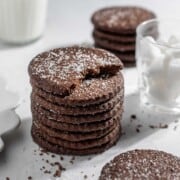
Chocolate Shortbreads
Ingredients
- 230 grams unsalted butter - or salted butter, but omit the extra salt in the recipe
- 110 grams icing sugar - otherwise known as powdered sugar
- 30 grams cocoa powder - use a good quality
- ½ teaspoon salt
- 1 teaspoon vanilla extract
- 220 grams all purpose flour
Instructions
- Add the softened butter and icing sugar to a large mixing bowl.230 grams unsalted butter, 110 grams icing sugar
- Using an electric hand mixer or stand mixer, beat the butter and icing sugar together until light and fluffy, about 2-3 minutes.
- Next, add in the cocoa powder, salt and vanilla extract to the butter and sugar mixture. Beat until everything is thoroughly combined and you have a smooth, creamy mixture.30 grams cocoa powder, ½ teaspoon salt, 1 teaspoon vanilla extract
- Add all of the all-purpose flour to the bowl. Slowly beat just until you cannot see any more specks of flour. We recommend starting with the electric mixer and finishing by hand, scraping down the sides and bottom of the bowl.220 grams all purpose flour
- Tip the cookie dough out onto a piece of plastic wrap.
- Shape it into a flat disk and wrap in the plastic wrap. Place in the fridge for a minimum of 1 hour, or in the freezer for 30 minutes.
- Once the dough is cold and firmed up, unwrap it and place on a sheet of parchment paper. Cover it with another piece of parchment paper.
- Using a rolling pin, roll the dough out to a thickness of 6mm/1/4".
- Cut out your desired shapes from the dough using a cookie cutter. Re-roll any leftover pieces of dough. If the dough has gone soft, return it to the fridge for 10 minutes.
- Line two baking trays with parchment paper and transfer the cut out cookies onto the trays, leaving enough space between them for expansion.
- Place the baking trays in the fridge to firm up the cookies.
- Preheat the oven to 170C/338F/gas mark 3.
- Once preheated, bake the cookies on the middle shelf of the oven for 15-17 minutes. Since the cookies are dark, you won't have visual cues like with light cookies. Look for a dull surface and dry edges to know they are done.
- Leave the cookies on the trays for 10 minutes before moving them to a wire rack to cool completely.
- If you wish, sprinkle them with granulated sugar as soon as they come out of the oven. Gently press down to make the sugar stick.
Notes
Weigh your ingredients accurately
Using a digital scale to weigh out your ingredients will always give you more accurate results. If you haven't got a set of digital kitchen scales, consider adding it to your Christmas list.Don't overmix the dough
For best results, don't overmix the cookie mixture. Overmixing might lead to tougher cookies. Gently fold the ingredients together and stop as soon as everything has been incorporated.Chilling the dough is a *must*
The dough is fairly soft, so chilling it in the fridge before rolling and cutting is a essential. After mixing, shape the dough into a flat disk, wrap it in cling film and chill it in the fridge for at least 1 hour or in the freezer for 30 minutes. This firms up the dough and makes it much easier to work with. If any leftover dough scraps soften up while cutting shapes, simply return them to the fridge for 10 minutes to firm up again. Another great technique is to roll out the dough on parchment paper to the desired thickness right away, transfer it to a baking sheet and place the sheet in the fridge until firm before cutting shapes. Chilling helps retain the dough's shape for cutting neat cookies. So, take advantage of your fridge or freezer to ensure these cookies turn out just the way they should.Re-chill the cut out cookies before baking
Re-chilling the cut out cookies before baking is an important extra step. While rolling and handling the dough, it can start to warm up and soften, especially if your kitchen is hot, you're under bright lights or your hands run warm. Wait to preheat the oven until after you have transferred all the cut out cookies to a cookie sheet and returned them to the fridge to firm up one last time. This second chill hardens the dough again and helps the shapes retain their form when hit with the heat of the oven. So really, really resist the urge to bake them immediately! Allowing the cut cookies to re-chill will ensure you end up with beautifully defined edges and details.How to tell if your cookies are done
With chocolate cookies, it can be tricky to gauge doneness since you don't have the same visual cues as lighter-coloured baked goods.-
- First, trust your nose - when they're done baking, you'll smell that irresistible chocolate aroma.
-
- Check the surface of the cookies too. When done, they will have a dull, matte look rather than a glossy wet appearance.
-
- Press gently on the edges of the cookies. If they feel quite firm and almost dry, they are likely fully baked.
-
- Keep in mind that cookies continue cooking even once removed from the oven. To avoid overbaking, be cautious and pull them when you think they seem just shy of done. It's better to have cookies that are slightly underbaked rather than dried out.
A bonus 'nice-to-have'
Invest in a rolling pin with built-in guides or adjustable add-on guides for easy, tidy rolling. The guides act as a frame of reference so you can roll the dough precisely to the desired thickness all over. Perhaps something else to add to your Christmas list!**Nutritional data disclaimer**
Please keep in mind that the nutritional information provided below is calculated by a third party and we cannot guarantee the accuracy. We try our best to give you the most accurate information, but we do not take responsibility for errors that may be present. Also, the nutritional value of the recipe may change depending on the exact brands and products used. We recommend that you consult with a qualified healthcare professional or registered dietitian for personalised advice on your dietary needs.
Nutrition
For food safety advice, including guidance on food allergies




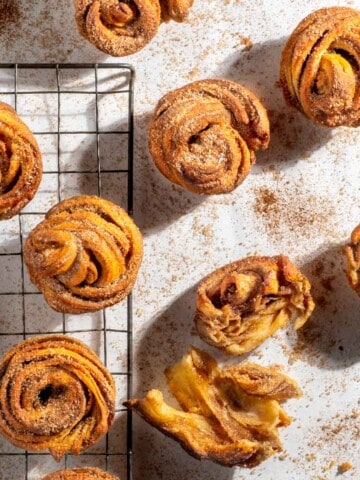
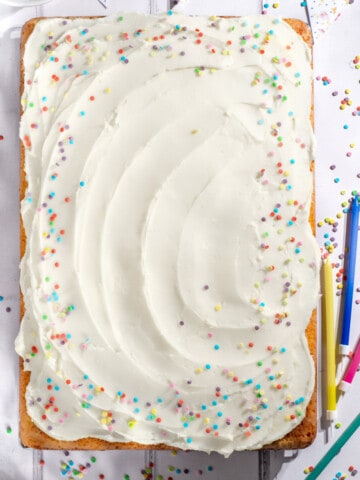
Leave a Reply